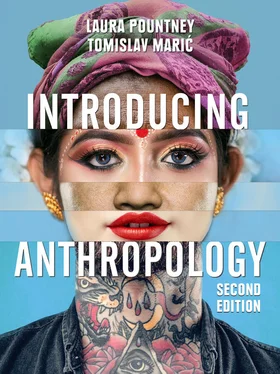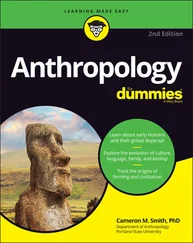1 ...7 8 9 11 12 13 ...35 Make a list of the differences and similarities between humans, bonobos and chimpanzees. Are there more similarities or more differences?
Tool-use was once thought to be one of the characteristics that set humans apart from other primates, and, indeed, if you look at the variety and complexity of the tools employed by humans, this would seem to be true. However, tool-use has been seen in a number of primate and nonprimate species, both in captivity and in the wild. The study of tool-use provides important information concerning the evolution of human abilities.
A tool can be defined as any object manipulated by an animal in order to perform a specific task. This tool usually has some beneficial effect, such as making a task easier. Therefore, a tool can be very simple, such as a stick to scratch the animal’s back. This sort of tool, which requires no alteration to be functional, is sometimes described as a ‘naturefact’. Tools used by nonhuman primates include stones, which might be used to cut, grind or scrape.
Chimpanzees, for example, often make use of tools. They will adapt sticks, rocks, grass and leaves and use them when foraging for honey, termites, ants, nuts and water. Despite the lack of complexity, there does seem to be planning and skill involved in using these tools. For example, when foraging, chimps will employ modified short sticks to scoop honey out of a hive – that is, if the bees are harmless. With the hives of the dangerous African honeybee, they use longer and thinner sticks to extract the honey. Modification of leaves and branches, and their use as simple tools, has also been observed in elephants, crows and dolphins. However, none of those species created or used more sophisticated tools, such as the stone tools that earlier hominins started to produce more than 2 million years ago. Human tools of course became much more complex and diverse: hunting tools, tools to create and control fire, and much more.
Modern chimpanzees occasionally walk upright, but their skeletons are not adapted for regular walking on two legs. The skeletons of early humans, on the other hand, evolved to support their bodies in an upright position. This means that modern humans have bodies adapted for walking and running long distances on two legs – that is, they are bipedal. Walking upright undoubtedly helped early humans survive in the diverse habitats in which they lived, including forests and grasslands. There are several physical changes that had to occur to make bipedalism possible, among them modifications in foot and knee structure, a curved spine (to absorb shock), broad-shaped hip bones, and a change in the point of attachment between the skull and the neck from a posterior position (as found in other primates) to an inferior position. Bipedalism was an adaptation to the open environments of the African savannah, where the earliest hominins evolved.
bipedalismWalking upright on two feet for the majority of time
One disadvantage of bipedalism is that climbing is much harder, as the feet cannot grip trees. Another disadvantage is the back pain and other skeletal problems that occur as a result of walking upright. Placing all the body’s weight on just two limbs can result in back pain and slipped discs. A further disadvantage of bipedalism was that it resulted in the narrowing of the hips and pelvis, resulting in greater risk in childbirth.
Human pelvis shape and size are different from those of other primates
As we have seen, bipedalism and the long, slim bodies that go with it were advantageous for humans to be able to move quickly and efficiently in the savannah environment. However, these changes also resulted in changes in the shape, size and position of the female pelvis, which meant a narrower birth canal in females. As a consequence, giving birth became a more difficult and risky process for humans than for most other primate species. The result is that humans give birth to babies that have not achieved the stage of brain development that is typical at birth for apes, monkeys and most other mammals. This particular feature of our evolution appears to be quite recent; it was around 500,000 years ago that there was evidence of the large human brain.
mammalAny warm-blooded vertebrate animal, including humans, characterized by a covering of hair on the skin and, in the female, milk-producing mammary glands for feeding the young
During delivery, human babies must turn to be able to squeeze through the narrow birth canal in order to accommodate their comparatively large heads followed by their shoulders. The way that this is achieved is by babies having a soft skull that is not fully formed at birth. Birth, therefore, is usually a long, tiring and painful process for the mother as well as a risky one for the baby. Because of this, unlike other primates, human mothers generally need help in childbirth.
The consequence of this evolutionary adaptation is that newborn human babies are more vulnerable and undeveloped. The bones of the skull grow and fuse together during the first year of life, which means that human babies are extremely vulnerable during this time and in need of a lot of protection and nurturing.
Summarize the benefits and disadvantages of bipedalism for humans.
Hairless bodies and sweating
Another way in which humans are different from other primates is in having a largely hairless body, along with a very efficient set of sweat glands that allow the regulation of body temperature, as opposed to panting, like many other mammals. Humans are the only primate species that has mostly naked skin. However, scientists are still trying to find out which hominins were the first to have lost their body hair. If the advantage of naked skin was the ability to regulate body temperature in the open environment of the savannah, in contrast to the more shaded forests where apes live, then our naked skin may have evolved million years ago.
One of the most significant differences between humans and other primates is that humans have a much larger brain. The modern human brain is three times larger in volume than that of the great ape. But it is not just the size of the human brain that is significant; it is the complex functional and cognitive abilities the brain engenders. However, a larger brain is also a more expensive brain. The human brain to body size ratio is significantly greater than in other species, and as a result the human brain requires 20 per cent of the energy used by the body, which is more than any other organ. The evolution of a larger brain suggests that a higher energy diet had also to evolve as a condition. Although the hominin lineage is over 6 million years old, brain size shows significant increases only from the time of Homo erectus , less than 2 million years ago. It was also around that time that we find evidence of a dramatic change in diet towards increased meat eating, more extensive use and manufacture of stone tools, and reduction in jaw and tooth size.
Large, complex brains can process and store a lot of information. This was a big advantage to early humans in their social interactions and encounters with unfamiliar habitats. Having a larger brain enabled modern humans to have much more complex forms of verbal communication than any other primate species. Humans are the only animal to create and use symbols as a means of communication. Humans also have more varied and complex social organizations. The most distinctive feature of humans is our mental ability to create new ideas and complex technologies, which has proved to be invaluable in the competition for survival. Another striking capability that derives from a larger and more effective brain is the ability to know what others might be thinking. In psychology, this is known as having a ‘theory of mind’.
Читать дальше












